Case Study of Solid Waste Based Soft Soil Solidifying Materials Applied in Deep Mixing Pile
Abstract
:Highlights
- The solidifying agent deep mixing pile showed excellent early strength and late strength.
- The mechanism of solidifying agent to solidify organic clay was analyzed.
- The integrity of the solidifying agent mixing pile was significantly improved by a meniscus blade.
- Mixing a total of four times is suitable for the construction of the solidifying agent deep mixing pile.
Abstract
1. Introduction
2. Materials and Methods
2.1. Materials
- (1)
- Green soft soil solidifying agent
- (2)
- Geotechnical parameters of experiment field
2.2. Field Experiment
- (1)
- Deep mixing pile machine
- (2)
- Construction technology
2.3. Unconfined Compressive Strength Test
2.4. Microscopic Analysis
3. Result and Discussion
3.1. Effect of the Shape of Blade
3.2. Effect of Mixing Times
3.3. Effect of Types of Solidifying Materials
3.4. Effect of Content of Solidifying Agent
3.5. Microcosmic Analysis
3.6. Mechanism Analysis
4. Conclusions
- (1)
- The utilization of meniscus blades contributed to the excellent integrity of the deep mixing pile. Meanwhile, the homogeneity of the deep mixing pile was significantly improved. Mixing times and the type of solidifying material are not the key factors affecting the integrity. For the construction of deep mixing piles in organic clay, mixing a total of four times is the most suitable.
- (2)
- The strength of the solidifying agent deep mixing pile was nearly three times that of the cement deep mixing pile (65 kg/m). The solidifying agent deep mixing pile showed satisfactory early and late mechanical properties. With the content of the solidifying agent, the early strength (14 d) and late strength (28 d) of the deep mixing pile both gradually increased. Under the content of 50 kg/m of the solidifying agent, the unconfined compressive strength of the deep mixing pile at the curing periods of 14 d and 28 d are 1.13 MPa and 1.54 MPa, respectively. When the content of the solidifying agent is increased to 100 kg/m, the unconfined compressive strength of the deep mixing pile at the curing periods of 14 d and 28 d are 2.15 MPa and 2.97 MPa, respectively.
- (3)
- Compared with the cement solidified soil, more calcium silicate hydrate and AFt were generated in the solidifying agent solidified soil. Soil particles were better cemented by C-S-H and AFt, meanwhile the pores were fully filled. The integral and dense structure was formed under the solidification of the solidifying agent. Therefore, the solidifying agent deep mixing pile showed the characteristics of excellent integrity, early strength and late strength.
Author Contributions
Funding
Institutional Review Board Statement
Informed Consent Statement
Data Availability Statement
Acknowledgments
Conflicts of Interest
References
- Chaibeddra, S.; Kharchi, F. Performance of Compressed Stabilized Earth Blocks in sulphated medium. J. Build. Eng. 2019, 25, 100814. [Google Scholar] [CrossRef]
- Elkhebu, A.; Zainorabidin, A.; Bakar, I.H.; Huat, B.B.K.; Dheyab, W.K. Alkaline Activation of Clayey Soil Using Potassium Hydroxide & Fly Ash. Int. J. Integr. Eng. 2018, 10, 99–104. [Google Scholar]
- Kanty, P.; Rybak, J.; Stefaniuk, D. Some Remarks on Practical Aspects of Laboratory Testing of Deep Soil Mixing Composites Achieved in Organic Soils. IOP Conf. Ser. -Mater. Sci. Eng. 2017, 245, 022018. [Google Scholar] [CrossRef] [Green Version]
- Timoney, M.J.; Mccabe, B.A.; Bell, A.L. Experiences of dry soil mixing in highly organic soils. Proc. Inst. Civ. Eng. Ground Improv. 2012, 165, 3–14. [Google Scholar] [CrossRef]
- Wattez, T.; Patapy, C.; Frouin, L.; Waligora, J.; Cyr, M. Interactions between alkali-activated ground granulated blastfurnace slag and organic matter in soil stabilization/solidification. Transp. Geotech. 2021, 26, 100412. [Google Scholar] [CrossRef]
- Charitha, V.; Athira, G.; Shekhar, S. Carbonation of alkali activated binders and comparison with the performance of ordinary Portland cement and blended cement binders. J. Build. Eng. 2022, 53, 104513. [Google Scholar] [CrossRef]
- Odeh, N.A.; Al-Rkaby, A.H.J. Strength, Durability, and Microstructures characterization of sustainable geopolymer improved clayey soil. Case Stud. Constr. Mater. 2022, 16, e00988. [Google Scholar] [CrossRef]
- Vaiciukyniene, D.; Tamosaitis, G.; Kantautas, A.; Nizeviciene, D.; Pupeikis, D. Porous alkali-activated materials based on municipal solid waste incineration ash with addition of phosphogypsum powder. Constr. Build. Mater. 2021, 301, 123962. [Google Scholar] [CrossRef]
- Chen, Q.S.; Tao, Y.B.; Feng, Y.; Zhang, Q.L.; Liu, Y.K. Utilization of modified copper slag activated by Na2SO4 and CaO for unclassified lead/zinc mine tailings based cemented paste backfill. J. Environ. Manag. 2021, 290, 112608. [Google Scholar] [CrossRef]
- Balun, B.; Karatas, M. Influence of curing conditions on pumice-based alkali activated composites incorporating Portland cement. J. Build. Eng. 2021, 43, 102605. [Google Scholar] [CrossRef]
- Kadhim, A.; Sadique, M.; Al-Mufti, R.; Hashim, K. Developing one-part alkali-activated metakaolin/natural pozzolan binders using lime waste. Adv. Cem. Res. 2021, 33, 342–356. [Google Scholar] [CrossRef]
- Mahmoud, M.; Kraxner, J.; Bernardo, E. Porous Glass Microspheres from Alkali-Activated Fiber Glass Waste. Materials 2022, 15, 1043. [Google Scholar] [CrossRef] [PubMed]
- Shu, B.A.; Zhou, M.; Yang, T.Y.; Li, Y.L.; Song, P.T.; Chen, A.Q.; Barbieri, D.M. Performance study and engineering application of grouting materials with a large content of solid waste. Constr. Build. Mater. 2021, 312, 125464. [Google Scholar] [CrossRef]
- Seo, E.A.; Yoon, H.S.; Kim, D.G.; Yang, K.H.; Nguyen, V.T. Feasibility tests on ground granulated powders compiled from waste concrete for soil solidification. Eur. J. Environ. Civ. Eng. 2021, 1963843. [Google Scholar] [CrossRef]
- Abhishek, H.S.; Prashant, S.; Kamath, M.V.; Kumar, M. Fresh mechanical and durability properties of alkali-activated fly ash-slag concrete: A review. Innov. Infrastruct. Solut. 2022, 7, 116. [Google Scholar] [CrossRef]
- Chen, R.F.; Congress, S.S.C.; Cai, G.J.; Duan, W.; Liu, S.Y. Sustainable utilization of biomass waste-rice husk ash as a new solidified material of soil in geotechnical engineering: A review. Constr. Build. Mater. 2022, 292, 123219. [Google Scholar] [CrossRef]
- Dong, Y.Q.; Zhou, M.; Hou, H.B. Barrier effect of coal bottom ash-based geopolymers on soil contaminated by heavy metals. RSC Adv. 2019, 9, 28695–28703. [Google Scholar] [CrossRef] [Green Version]
- Parthiban, D.; Vijayan, D.S.; Duc, B.V. Role of industrial based precursors in the stabilization of weak soils with geopolymer—A review. Case Stud. Constr. Mater. 2022, 16, e00886. [Google Scholar] [CrossRef]
- Wu, J.; Deng, Y.F.; Zhang, G.P.; Zhou, A.N.; Tan, Y.Z.; Xiao, H.L.; Zheng, Q.S. A Generic Framework of Unifying Industrial By-products for Soil Stabilization. J. Clean. Prod. 2021, 321, 128920. [Google Scholar] [CrossRef]
- Shen, J.S.; Xu, Y.D.; Wang, Y. Study on the Stabilization of a New Type of Waste Solidifying Agent for Soft Soil. Materials 2019, 12, 826. [Google Scholar] [CrossRef] [Green Version]
- Deng, Y.F.; Xu, C.C.; Marsheal, F.; Geng, X.Y.; Chen, Y.G.; Sun, H.L. Constituent Effect on Mechanical Performance of Crushed Demolished Construction Waste/Silt Mixture. Constr. Build. Mater. 2021, 294, 123567. [Google Scholar] [CrossRef]
- Deng, Y.F.; Xue, H.C.; Wu, Y.X.; Zhang, T.W.; Wu, Z.L.; Chu, C.F. Effects of Porewater Salinity on Soil Identification using In-Situ Cone Penetration Test. Eng. Geol. 2021, 292, 106252. [Google Scholar] [CrossRef]
- Shu, B.A.; Yang, T.Y.; Li, Y.L.; Ren, Y.F.; Zheng, L.S. Effect of alkali-activated steel slag powder on solidification performance of silt soil. New Build. Mater. 2022, 49, 83–86. (In Chinese) [Google Scholar]
- Latifi, N.; Horpibulsuk, S.; Meehan, C.L.; Abd Majid, M.Z.; Tahir, M.M.; Mohamad, E.T. Improvement of Problematic Soils with Biopolymer—An Environmentally Friendly Soil Stabilizer. J. Mater. Civ. Eng. 2017, 29, 04016204. [Google Scholar] [CrossRef]
- Gautam, S.; Hoyos, L.R.; He, S.; Harmon, J.S.; Shaw, K.S.; Albers, H. Chemical Treatment of a Highly Expansive Clay Using a Liquid Ionic Soil Stabilizer. Geotech. Geol. Eng. 2020, 38, 4981–4993. [Google Scholar] [CrossRef]
- Kushwaha, S.S.; Kishan, D.; Dindorkar, N. Stabilization of Expansive Soil Using Eko Soil Enzyme For Highway Embankment. Mater. Today: Proc. 2018, 5, 19667. [Google Scholar] [CrossRef]
- Disfani, M.M.; Mohammadinia, A.; Arulrajah, A.; Horpibulsuk, S.; Leong, M. Lightly Stabilized Loose Sands with Alkali-Activated Fly Ash in Deep Mixing Applications. Int. J. Geomech. 2021, 21, 04021011. [Google Scholar] [CrossRef]
- Egorova, A.; Rybak, J.; Stefaniuk, D.; Zajaczkowski, P. Basic Aspects of Deep Soil Mixing Technology Control. Iop Conf. 2017, 245, 022019. [Google Scholar] [CrossRef]
- Kiecana, M.; Kanty, P.; Luzynska, K. Optimal control time evaluation for “dry DSM” soil-cement composites. MATEC Web Conf. 2018, 251, 01023. [Google Scholar] [CrossRef]
- Zhou, S.Q.; Zhang, Y.F.; Zhou, D.W.; Wang, W.J.; Ke, Z.B.; Halder, S. Fly ash foundation reinforced by cement-soil mixing piles. DYNA 2020, 95, 209. [Google Scholar]
- Lu, X.H.; Cui, M.X.; Wang, P.F.; Li, B. Application in Cement Soil of Stabilizer in Silt Soft Soil of Wuxi in China. J. Coast. Res. 2018, 83, 316–323. [Google Scholar] [CrossRef]
- Hong, Y.W.; Wu, X.P.; Zhang, P. Construction Technology and Mechanical Properties of a Cement-Soil Mixing Pile Reinforced by Basalt Fibre. Adv. Mater. Sci. Eng. 2017, 2017, 9736465. [Google Scholar] [CrossRef] [Green Version]
- Ke, R.; Wang, H.X.; Tan, Y.Z.; Wang, L.H. Solidification of High Organic Matter Content Sludge by Cement, Lime and Metakaolin. Period. Polytech. -Civ. Eng. 2019, 63, 53–62. [Google Scholar]
- Tan, Y.Z.; Ke, R.; Ming, H.J. Improving the durability of organic matter in cement-treated sludge using metakaolin and lime. Mar. Georesources Geotechnol. 2021, 39, 293–301. [Google Scholar] [CrossRef]
- Wu, J.; Liu, L.; Deng, Y.F.; Zhang, G.P.; Zhou, A.N.; Xiao, H.L. Use of recycled gypsum in the cement-based stabilization of very soft clays and its micro-mechanism. J. Rock Mech. Geotech. Eng. 2022, 14, 909–921. [Google Scholar] [CrossRef]
- Jiang, M.Q.; Yang, D.Y. Resume of Research Progresses of Ettringite in Concrete. Build. Tech. Dev. 2004, 31, 132–135. (In Chinese) [Google Scholar] [CrossRef]
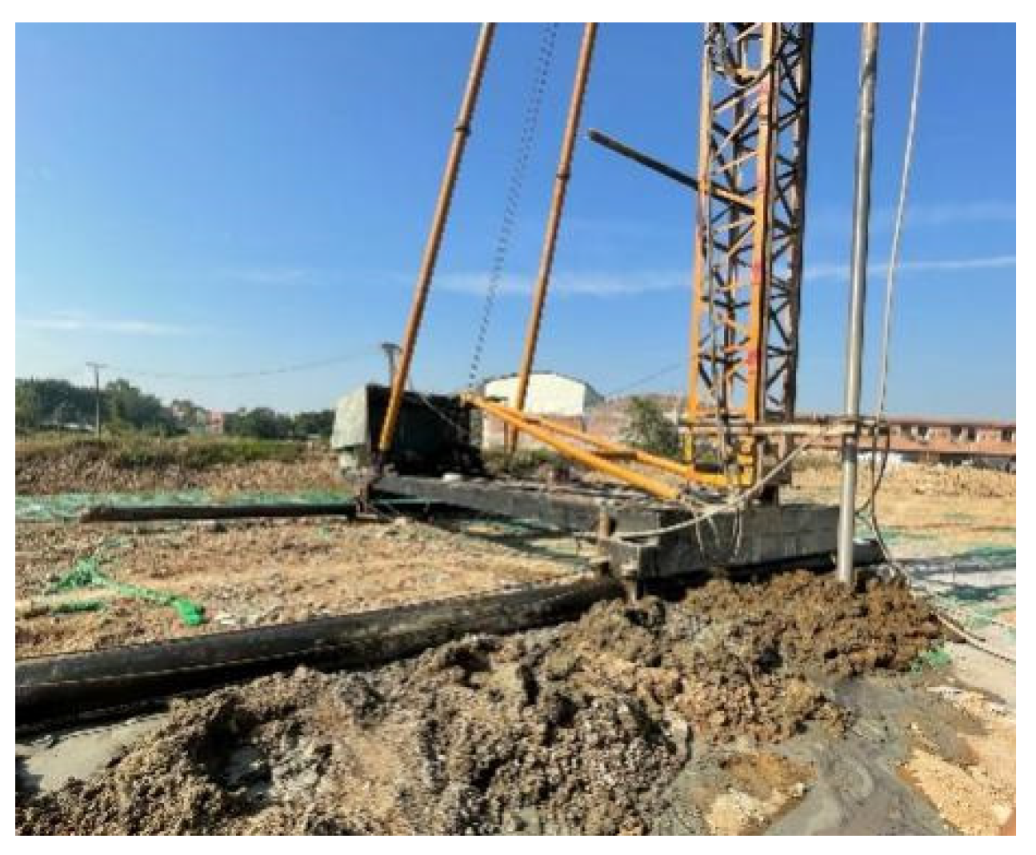



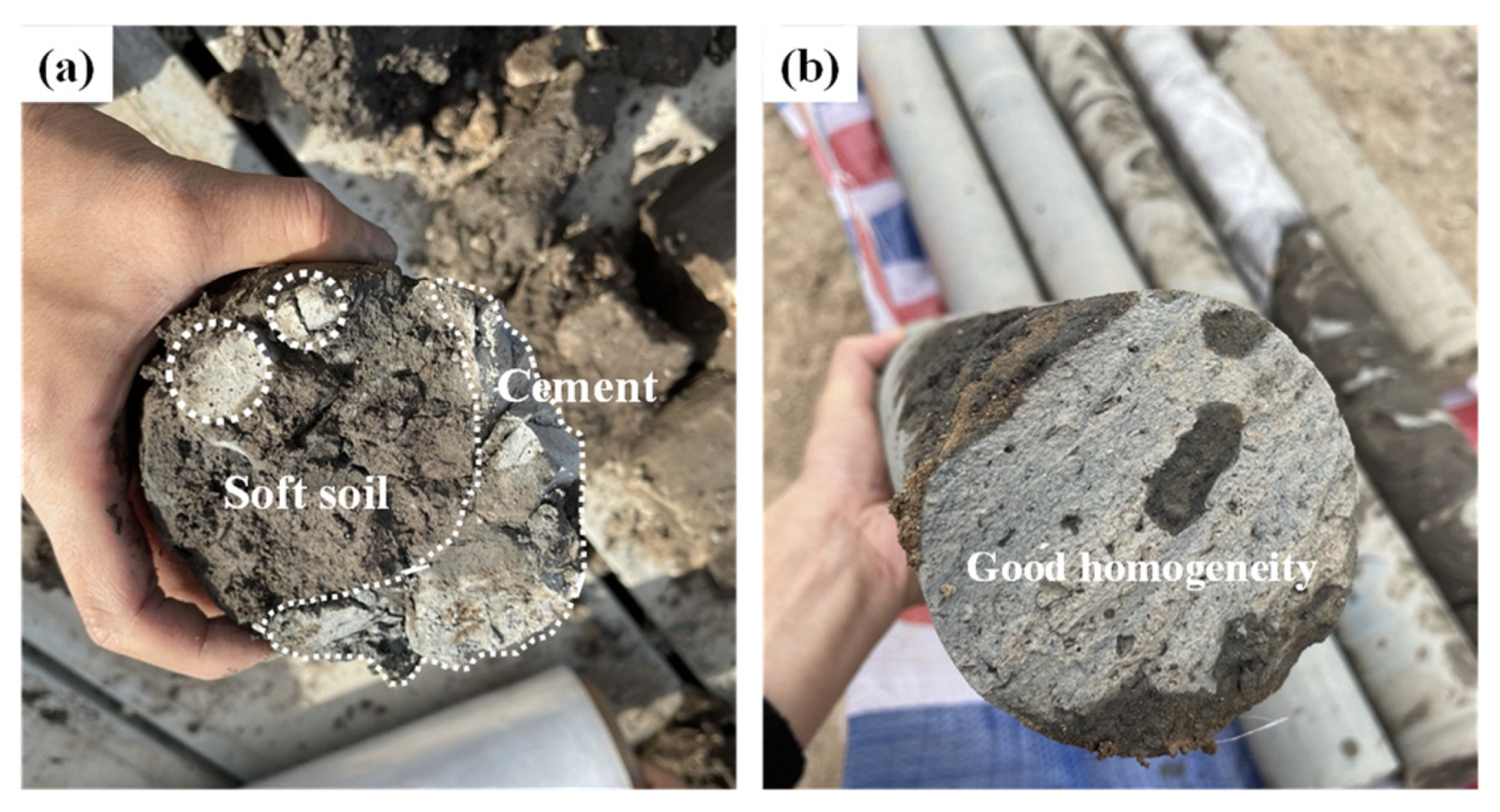


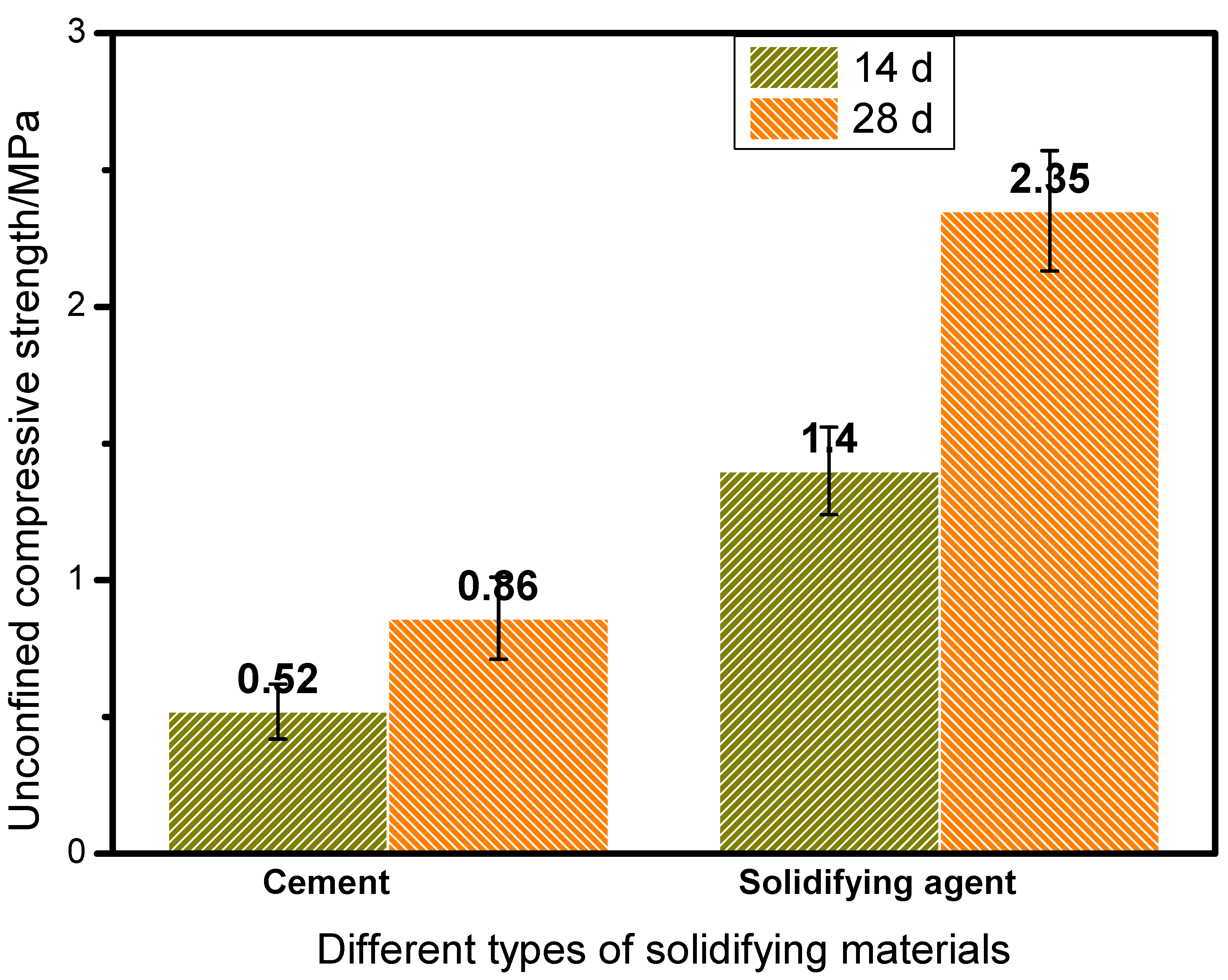
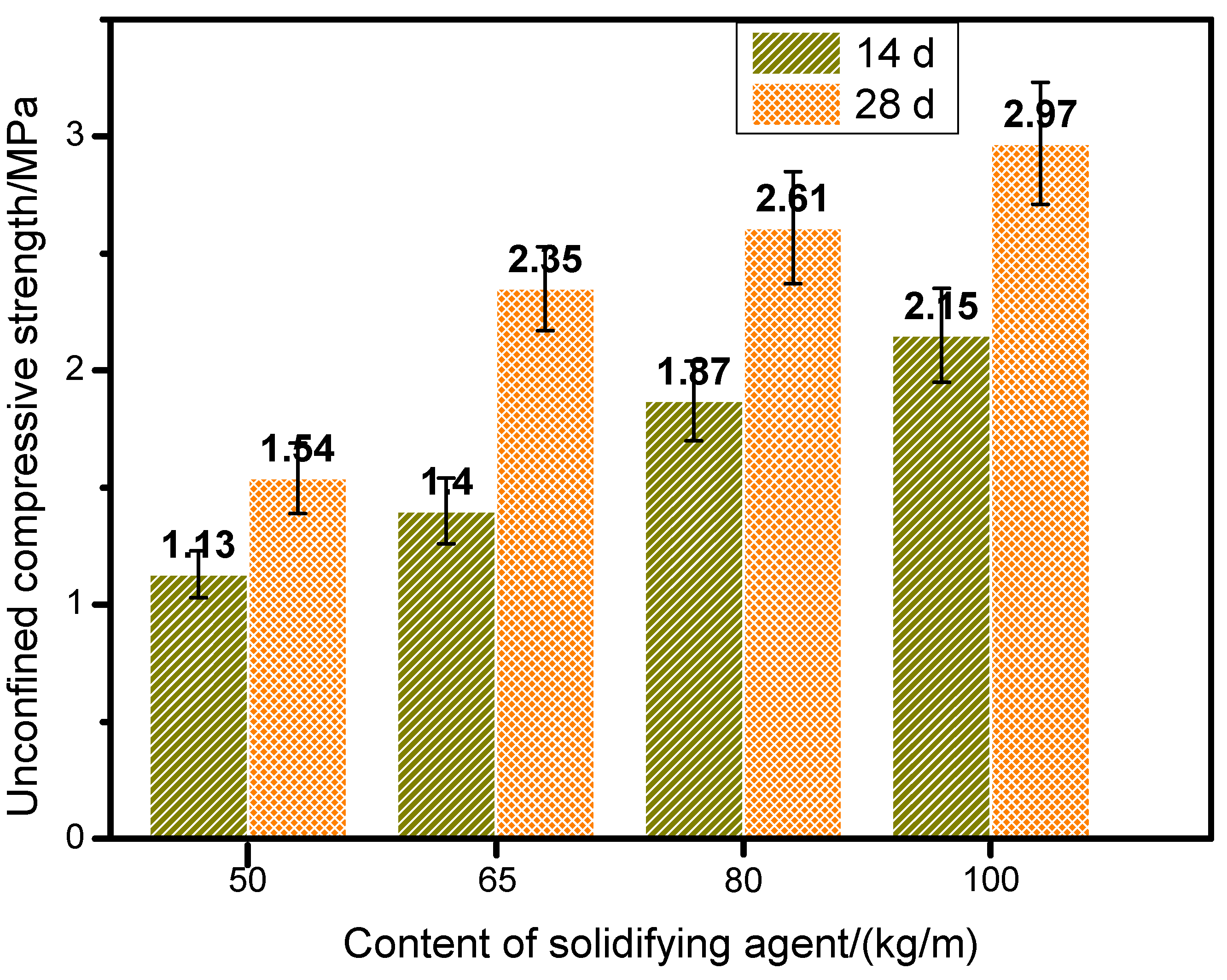

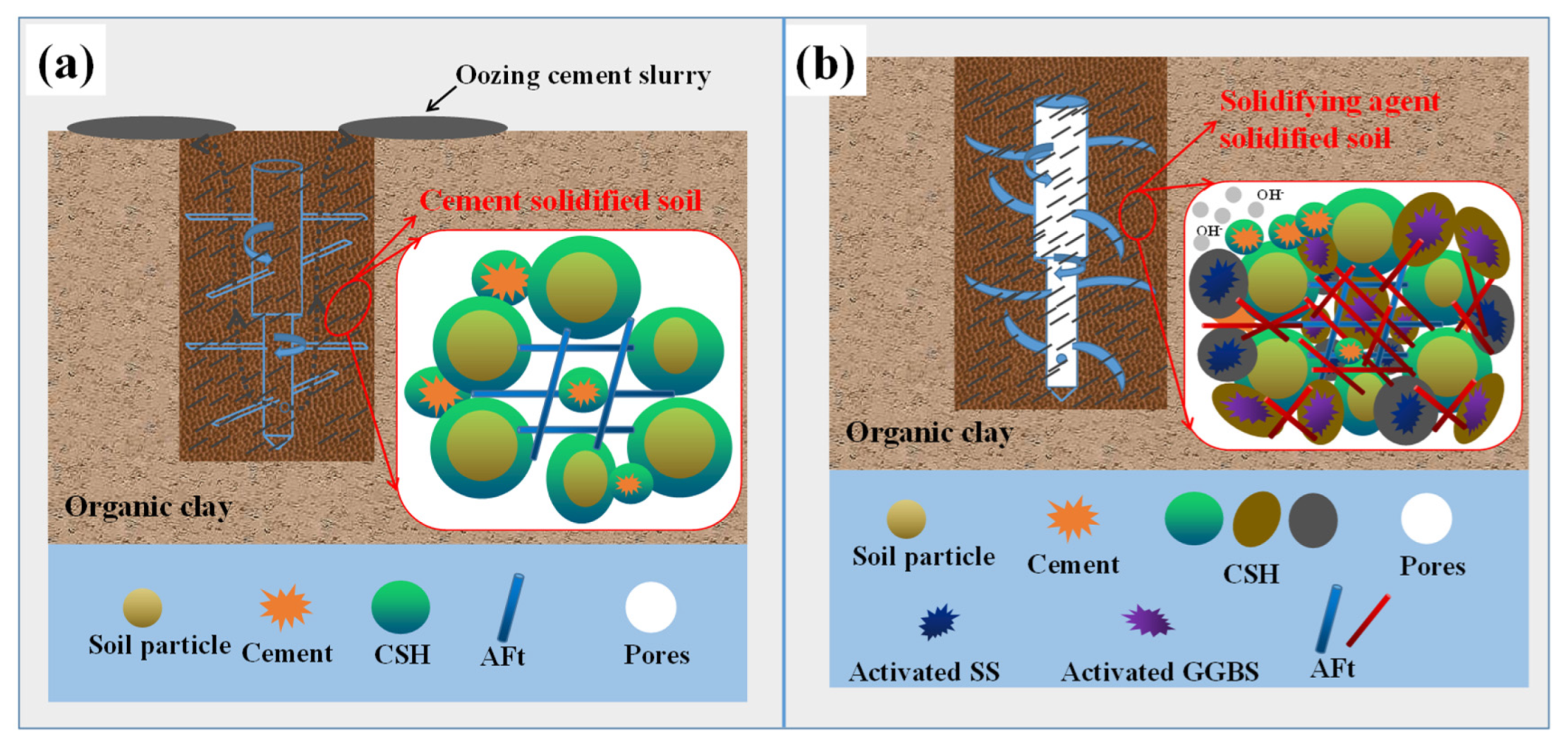
| Performance Index | Moisture Content/% | Fineness (>80 μm) | Initial Setting Time/min | Fluidity of Solidifying Agent Paste (25 °C)/s | Mortar Strength/MPa | |||
|---|---|---|---|---|---|---|---|---|
| Initial | 30 min | 60 min | 7 d | 28 d | ||||
| Specification requirements | ≤1 | ≤10 | ≥45 | ≥100 | ≥90 | ≥80 | / | / |
| Experimental result | 0.7 | 5 | 130 | 240 | 210 | 170 | 35.6 | 41.8 |
| Geotechnical Parameters | Natural Moisture Content/% | Organic Matter Content/% | Specific Gravity, g/cm3 | Liquid Limit/% | Plastic Limit/% | <0.075 mm,% | USCS Soil Classification |
|---|---|---|---|---|---|---|---|
| Test result | 103.2 | 12.1 | 1.69 | 51.5 | 40.56 | 54.5 | OH |
| Diameter of Mixing Pile/mm | Length of Mixing Pile/m | Shape of Mixing Blade | Type of Solidifying Materials | Mixing Content of Solidifying Agent (kg/m) | Number of Mixing Times |
|---|---|---|---|---|---|
| 0.5 | 11.5 | Strip, Meniscus | Solidifying agent, P O 42.5 Cement | 50, 65, 80, 100 | Two, Four, Six |
| Mixing Times | Efficiency | Oozing Cement Paste | Integrity |
|---|---|---|---|
| two | 23.1 min | yes | excellent |
| four | 46.3 min | no | excellent |
| six | 69.3 min | no | excellent |
Publisher’s Note: MDPI stays neutral with regard to jurisdictional claims in published maps and institutional affiliations. |
© 2022 by the authors. Licensee MDPI, Basel, Switzerland. This article is an open access article distributed under the terms and conditions of the Creative Commons Attribution (CC BY) license (https://creativecommons.org/licenses/by/4.0/).
Share and Cite
Shu, B.; Gong, H.; Chen, S.; Ren, Y.; Li, Y.; Yang, T.; Zeng, G.; Zhou, M.; Barbieri, D.M.; Li, Y. Case Study of Solid Waste Based Soft Soil Solidifying Materials Applied in Deep Mixing Pile. Buildings 2022, 12, 1193. https://doi.org/10.3390/buildings12081193
Shu B, Gong H, Chen S, Ren Y, Li Y, Yang T, Zeng G, Zhou M, Barbieri DM, Li Y. Case Study of Solid Waste Based Soft Soil Solidifying Materials Applied in Deep Mixing Pile. Buildings. 2022; 12(8):1193. https://doi.org/10.3390/buildings12081193
Chicago/Turabian StyleShu, Benan, Haoliang Gong, Shaoming Chen, Yanfei Ren, Yongling Li, Tengyu Yang, Guodong Zeng, Min Zhou, Diego Maria Barbieri, and Yuanyuan Li. 2022. "Case Study of Solid Waste Based Soft Soil Solidifying Materials Applied in Deep Mixing Pile" Buildings 12, no. 8: 1193. https://doi.org/10.3390/buildings12081193
APA StyleShu, B., Gong, H., Chen, S., Ren, Y., Li, Y., Yang, T., Zeng, G., Zhou, M., Barbieri, D. M., & Li, Y. (2022). Case Study of Solid Waste Based Soft Soil Solidifying Materials Applied in Deep Mixing Pile. Buildings, 12(8), 1193. https://doi.org/10.3390/buildings12081193








